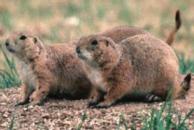

Genus: Cynomys
Species: ludovicianus

Imagine yourself on a huge open land with nothing to see but grass. when you look down you see a parade of little animals that almost look like squirrels. These are the prairie dogs. They are named after their dog-like yip.
If you have seen one, you'll agree they look cute, with their short legs and tails. Prairie dogs are cousins to ground squirrels. They have light
brown fur with lighter underparts. Their tails are kind of flat, usually with a black tip at the end. They have round heads with large eyes and tiny round ears. The adults usually weigh around 1 to 3 1/2 pounds There are two types of prairie dogs; black-tailed and white-tailed. Most common is the black-tailed prairie dog.The prairie dogs range from Canada to northern Mexico. The white-tailed prairie dogs are found around the prairies of southern Montana to northern Arizona. Prairie dogs live together in a system of burrows called "towns". These towns are broken up into family groups called "coteries". The burrows usually have two or more entrances to bring in fresh air and for quick escapes in times of trouble. Prairie dogs don't like shrubby places because they can't see predators coming. They will chew through tall weeds around their towns so they can see farther. That is also why prairie dogs live on the short grass prairies.
They come out or their burrows during the day to eat. Their diets consist mostly of grasses and herbs. Sounds a little boring, but when they find them, they will also eat grasshoppers and other small insects.
The black-tailed prairie dog becomes mature at 2 years. They will mate in the early spring, from February to March. The female is pregnant for 34 to 37 days. There are 1 to 6 babies in a litter who are born blind and hairless. They only have one litter a year. The babies come out from the burrows after 5-6 weeks. Until then their mother nurses them. Prairie dog females can live up to 8 years, but the males only live to be 5 years.
The thing that is so special about prairie dogs is that they are very social animals. Kind of like teenage girls! They make their burrows connecting to each other so they can visit anytime they want. When they meet they will kiss and nuzzle each other. They groom and play together and talk to each other by yipping. If you were to ever see a prairie dog, its likely it'll have a couple of friends with it.
They always have a sentry at a couple of entrances who sits straight up to look for predators. When they spot a predator they will bark out a warning and everybody dives for their burrows. They will wait for one of them to sound the all clear before going out again.
Prairie dogs are always busy at work. They work on their burrows from sunrise to sunset. The only problem with this is that ranchers live on the grassland too, and their cattle and livestock can step into a burrow and break or twist its leg.
Prairie dogs play an important role in the prairie. They are the major food source for many predators. Their empty burrows are used by the Burrowing Owl, the Texas Horned Lizard, the Black-footed Ferret and rabbits and hares. They also cut down large weeds and brush so they can see better. This keeps the prairies from getting overgrown with trees.
In the old days there was one huge prairie dog town that covered 25,000 square miles and had about 400 million prairie dogs in it. Now the prairie dog is still common, but there are less than 1% of the prairie dogs and their habitats left. But somewhere out there the prairie dog still roams the empty plains where Laura Ingals lived. And if you find the right place, you might spot a couple of heads peeking out from under the ground, trying to get a glimpse of you.
by Lauren F. 2000.
Bibliography:
World Book Encyclopedia, 2 Scott Ferzer Company, 1983-1996 World Book Inc.
"Animals", Groliers Multimedia Encyclopedia, (5/6/00).